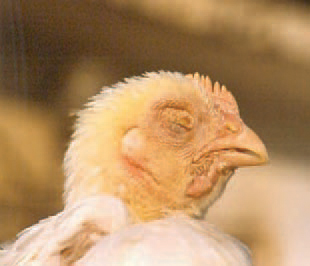Paratyphoid disease :
It is an important bacterial disease of chicken worldwide.
- Chicks from hatcheries are most at risk .
When chicks are raised by mother hen ; a chick gets beneficial microflora by consuming some of its mother fecal material , but no option in hatcheries.
- Zoonotics disease

Etiology :
It is caused by one of many non-host-adapted Salmonella. S. enterica enteritidis
Transmission :
- Horizontally via contaminated environment or infected rodents
- Vertical transmission to progeny from infected breeders through contamination of egg shell
- Transovarial transmission ( salmonella can infect the interior of egg )
Clinical signs :
- Lethargy
- Increased thirst
- Huddling near the source
- Pasty butt
- Swollen eye
- Swollen joints
- Droopy wings
- Decreased egg production
- Diarrhoea
- Cyanosis of comb and wattle
Postmortem finding :
Gross lesion:
a. Chicks :
- Focal or diffuse necrosis in liver
- Unabsorbed yolk sac
b. Adult :
- Splenomegaly
- Cu coloured enlarged liver with focal or diffuse area of necrosis
- Enteritis ( duodenum and jejunum )
- Pericardium may show milky fluid
- Infection occasionally localize in eye or synovial tissue

fig: Focal necrosis in liver

fig: unabsorbed yolk sacs
Microscopic lesions :
- SI : congestion and some mononuclear cell infiltration.
- Necrosis in the liver and heart with infiltration of heterophil and mononuclear cells.
- Necrosis of lymphocytes in lymphoid follicles of spleen.
- Lungs : reveal pneumonic lesions consisting of some heterophilic infiltration along with serous exudate
Diagnosis :
- History
- Clinical sign and lesion
- Isolation and identification of bacteria
- Antibiotic sensitivity test
- Ag detection test
- Whole blood agglutination test
DDx :
- Pasteurellosis : edema of combs and wattle , septicaemia , and bipolar staining organism
- Pullorum disease : chalk like diarrhoea , young chicks
- Coli-septicaemia : bronchopneumonia